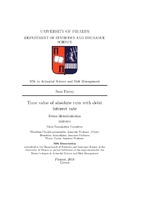| dc.description.abstractEN | In this Project, the surplus process is going to be studied under the scope of the classical continuous time risk model. Over the time, the surplus is continuously changing, receiving different values. In our study, two possible situations for the surplus are of great importance and significance. The first one is called "classical ruin", or just "ruin", and it happens when the surplus drops below zero for the first time (ruin time). The second one is called "absolute ruin" and it holds when the surplus falls below a negative critical value for the first time (absolute ruin time). In the last case, during the period in which the surplus is negative, insurance institutions can borrow money, with a debit interest rate, in order to compensate their obligations and the claims happening. On the other hand, their debt is paid back by the premiums earned. If the debt remains at a reasonable level, it is possible for the surplus to become positive again, resulting in the absolute ruin to be avoided. The objective of this thesis is to study and analyze risk measures related to both, classical ruin (chapter 1) and absolute ruin (chapter 2). Such measures will be the ruin probability and the Laplace transform of the ruin time. For this purpose, the expected discounted penalty function, or just Gerber-Shiu function, is defined and examined thoroughly, because, under specific circumstances, it is reduced to the aforementioned measures. Furthermore, at the end of each chapter, there are examples with explicit results for exponential claims. Finally, having assumed that there are dividend payments to shareholders according to a barrier strategy, we provide expressions for the moments of the present value of all dividends paid until the absolute ruin time, when the claims are exponentially distributed. | el |



